
Flaviviridae is a family of enveloped positive-strand RNA viruses which mainly infect mammals and birds. They are primarily spread through arthropod vectors. The family gets its name from the yellow fever virus; flavus is Latin for "yellow", and yellow fever in turn was named because of its propensity to cause jaundice in victims. There are 89 species in the family divided among four genera. Diseases associated with the group include: hepatitis (hepaciviruses), hemorrhagic syndromes, fatal mucosal disease (pestiviruses), hemorrhagic fever, encephalitis, and the birth defect microcephaly (flaviviruses).
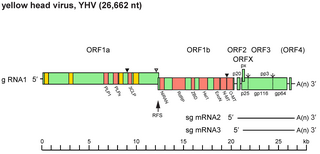
Okavirus is a genus of enveloped positive-strand RNA viruses which infect crustaceans. Host organisms are mostly shrimp. It is the only genus in the family Roniviridae. Viruses associated with the genus include: gill-associated virus (GAV) which causes reddening, biofouling with exoparasites, emaciation, and massive mortality; and yellow head virus (YHV) which causes yellow head, arrest of feeding, and massive mortality. The name is derived from the 'Oka' or lymphoid organ in which the viruses are commonly detected and in which pathology occurs during acute infections. Lymphoid organs are anatomical structures common to penaeid shrimp. There are three species in this genus.

Nodaviridae is a family of nonenveloped positive-strand RNA viruses. Vertebrates and invertebrates serve as natural hosts. Diseases associated with this family include: viral encephalopathy and retinopathy in fish. There are nine species in the family, assigned to two genera.
Mardivirus is a genus of viruses in the order Herpesvirales, in the family Herpesviridae, in the subfamily Alphaherpesvirinae. Chickens, turkeys, and quail serve as natural hosts. There are six species in this genus. Diseases associated with this genus include: Marek's disease, which causes asymmetric paralysis of one or more limbs, neurological symptoms, and development of multiple lymphomas that manifest as solid tumors. Gallid herpesvirus 2 is the only one of these viruses known to be pathogenic and due to the antigenic similarity between the three viruses the other two have been used to vaccinate against Marek's disease. These viruses have double stranded DNA genomes with no RNA intermediate.
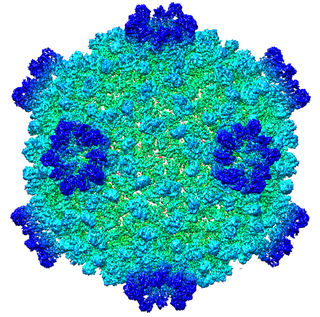
Cypovirus, short for cytoplasmic polyhedrosis virus, is a genus of double-stranded RNA viruses in the family Reoviridae and subfamily Spinareovirinae. Cypoviruses have only been isolated from insects. Diseases associated with this genus include chronic diarrhoea and pale blue iridescence in the guts of larvae. Sixteen species are placed in this genus.

Totivirus is a genus of double-stranded RNA viruses in the family Totiviridae. Fungi serve as natural hosts. The name of the group derives from Latin toti which means undivided or whole. There are seven species in this genus.

The golden shiner virus is an aquatic virus that infects a bait fish known as the golden shiner and to a lesser extent, aquatic animals like crustaceans and molluscs. About 6 virus species have been identified in this genus since the late 1970s. It causes death through a hemorrhagic shock. Symptoms include bleeding from the back eyes and the head. The virus is 70 nm in diameter and replicates best at 20-30 degrees Celsius. The virus has properties similar to those of the pancreatic necrosis virus. This could mean that golden shiners are more susceptible in the summer.

Alphachrysovirus is a genus of double-stranded RNA viruses. It is one of two genera in the family Chrysoviridae. They infect fungi, in particular Penicillium. Their name is derived from the Greek word chrysos which means yellow-green. There are 20 species in this genus.

Orthonairovirus is a genus of viruses in the family Nairoviridae of the order Bunyavirales that include viruses with circular, negative-sense single stranded RNA. It got its name from the Nairobi sheep disease that affects the gastrointestinal tracts of sheep and goats. The vast majority, and perhaps all viruses in this genus are tick-borne viruses that can have human or other vertebrate hosts.

Phytoreovirus is a genus of viruses, in the family Reoviridae, in the subfamily Sedoreovirinae. They are non-turreted reoviruses that are major agricultural pathogens, particularly in Asia. Oryza sativa for RDV and RGDV, dicotyledonous for WTV, and leafhoppers serve as natural hosts. There are three species in this genus. Diseases associated with this genus include: WTV: galls (tumor). RDV: dwarf disease of rice. RGDV: dwarfing, stunting, and galls.
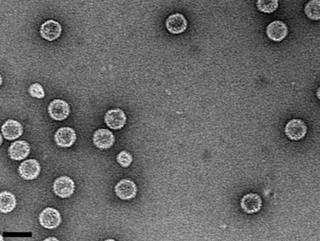
Picobirnavirus is a genus of double-stranded RNA viruses. It is the only genus in the family Picobirnaviridae. Although amniotes, especially mammals, were thought to serve as hosts, it has been recently suggested that these viruses might infect bacteria and possibly some other invertebrates. There are three species in this genus. Associated symptoms include gastroenteritis in animals and humans, though the disease association is unclear.
Cripavirus is a genus of viruses in the order Picornavirales, in the family Dicistroviridae. Invertebrates serve as natural hosts. There are four species in this genus. Diseases associated with this genus include: DCV: increased reproductive potential; extremely pathogenic when injected with high associated mortality; CrPV: paralysis and death. These viruses can produce proteins directly from their RNA genome upon entering a cell; and therefore, does not require an RNA polymerase packaged in with it, as this may be produced from the genome after entering the cell. The name of the cripavirus family originates from its most famous member the Cricket Paralysis Virus. Which was made famous by its rather unusual IRES : the Cripavirus IRES. The Cripavirus IRES is an RNA element that allows the virus to bind the ribosome and translate without a need for any initiation factors – as initiation is the most regulated step of translation this allows the virus to avoid many mechanisms to inhibit viral activity.
Aquabirnavirus is a genus of viruses, in the family Birnaviridae. Salmonid fish serve as natural hosts. There are three species in this genus. A disease associated with this genus, Infectious pancreatic necrosis (IPN) in salmonid fish, causes significant losses to the aquaculture industry. Chronic infection in adults, and acute viral disease in young salmonid fish can occur.
Blosnavirus is a genus of viruses, in the family Birnaviridae. Blotched snakehead fish serve as natural hosts. There are two species in this genus.
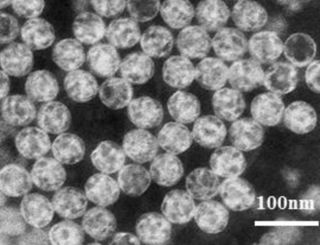
Mycoreovirus is a genus of double-stranded RNA viruses in the family Reoviridae and subfamily Spinareovirinae. Fungi serve as natural hosts. Diseases associated with this genus include: hypovirulence of the fungal host. The name of the group derives from Ancient Greek myco which means fungus. There are three species in this genus.
Oryzavirus is a genus of double-stranded RNA viruses in the family Reoviridae and subfamily Spinareovirinae. Member viruses infect plants and are transmitted by planthoppers. Diseases associated with this genus include: rice stunting, enations on veins of leaves and leaf sheaths, ragged leaves, and flower suppression. There are two species in this genus.
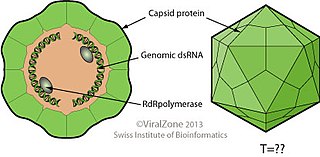
Megabirnaviridae is a family of double-stranded RNA viruses with one genus Megabirnavirus which infects fungi. The group name derives from member's bipartite dsRNA genome and mega that is greater genome size than families Birnaviridae and Picobirnaviridae. There is only one species in this family: Rosellinia necatrix megabirnavirus 1. Diseases associated with this family include: reduced host virulence.

Quadriviridae is a family of double-stranded RNA viruses with a single genus Quadrivirus. The fungi Rosellinia necatrix serves as a natural host. The name of the group derives from the quadripartite genome of its members where in Latin quad means four. There is only one species in this family: Rosellinia necatrix quadrivirus 1.
Cardoreovirus is a genus of double-stranded RNA viruses in the family Reoviridae and subfamily Sedoreovirinae. Crabs serve as natural hosts. There is only one species in this genus: Eriocheir sinensis reovirus. Diseases associated with this genus include: trembling disease. The name derives from Latin words "carcinus" which means crab and "doeca" which means twelve in reference to the number genome segments.

Dinovernavirus is a genus of double-stranded RNA viruses in the family Reoviridae and subfamily Spinareovirinae. Member viruses replicate in a variety of mosquito cell lines. The name is an abbreviation for double-stranded, insect, novem, rna virus. There is one species in the genus: Aedes pseudoscutellaris reovirus.
















